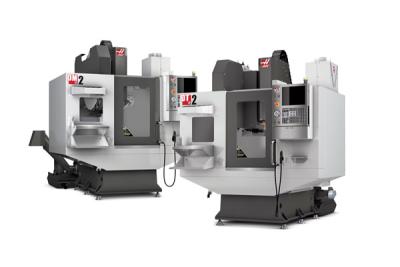
Haas Automation recently expanded its drill, tap and mill product line with a pair of high-speed, lean-style machining centers—the DT-2 and DM-2—that reportedly provide the same high acceleration rates, fast axis speeds and short tool change times as their smaller brethren. Yet, the new machines offer an additional 8" (203mm) of X-axis travel and table length, with only a slight increase in footprint.
The new DT-2 and DM-2 are identical in specifications to the DT-1 Drill/Tap Center and DM-1 Drill/Mill Center, except for spindle taper and tool changer, according to Haas. The DT-2 is a BT30 taper machine, with a 15,000-rpm inline direct-drive spindle and a high-speed 20+1 side-mount tool changer. It is available with an optional 20,000-rpm spindle.
The DM-2 is a 40-taper machine, with a 15,000-rpm inline direct-drive spindle and a high-speed 18+1 side-mount tool changer. The new DT and DM both allow high-speed rigid tapping to 5,000 rpm, with up to four times retract speed to shorten tapping cycles.
Both machines offer a 28" x 16" x 15.5" (508mm x 406mm x 394mm) work cube and a 34" x 15" (864mm x 381mm) T-slot table.
The increased table size, longer X-axis travel, and larger work envelope accommodate multiple fixtures and multi-spindle rotary tables for increased production and setup flexibility, according to Haas. Yet, their compact footprint still allows multiple machines to be placed side-by-side for efficient use of valuable shop floor space.
The spindle on both machines features a 15 hp (11.2 kW) vector drive system that provides 62 Nm of cutting torque. Cutting feedrates for both machines are 1,200 ipm (30.5 m/min), and 2,400 ipm rapids and high acceleration rates combine to shorten cycles times and increase throughput.
Contact Details
Related Glossary Terms
- inches per minute ( ipm)
inches per minute ( ipm)
Value that refers to how far the workpiece or cutter advances linearly in 1 minute, defined as: ipm = ipt 5 number of effective teeth 5 rpm. Also known as the table feed or machine feed.
- milling machine ( mill)
milling machine ( mill)
Runs endmills and arbor-mounted milling cutters. Features include a head with a spindle that drives the cutters; a column, knee and table that provide motion in the three Cartesian axes; and a base that supports the components and houses the cutting-fluid pump and reservoir. The work is mounted on the table and fed into the rotating cutter or endmill to accomplish the milling steps; vertical milling machines also feed endmills into the work by means of a spindle-mounted quill. Models range from small manual machines to big bed-type and duplex mills. All take one of three basic forms: vertical, horizontal or convertible horizontal/vertical. Vertical machines may be knee-type (the table is mounted on a knee that can be elevated) or bed-type (the table is securely supported and only moves horizontally). In general, horizontal machines are bigger and more powerful, while vertical machines are lighter but more versatile and easier to set up and operate.
- tap
tap
Cylindrical tool that cuts internal threads and has flutes to remove chips and carry tapping fluid to the point of cut. Normally used on a drill press or tapping machine but also may be operated manually. See tapping.
- tapping
tapping
Machining operation in which a tap, with teeth on its periphery, cuts internal threads in a predrilled hole having a smaller diameter than the tap diameter. Threads are formed by a combined rotary and axial-relative motion between tap and workpiece. See tap.
- work envelope
work envelope
Cube, sphere, cylinder or other physical space within which the cutting tool is capable of reaching.
